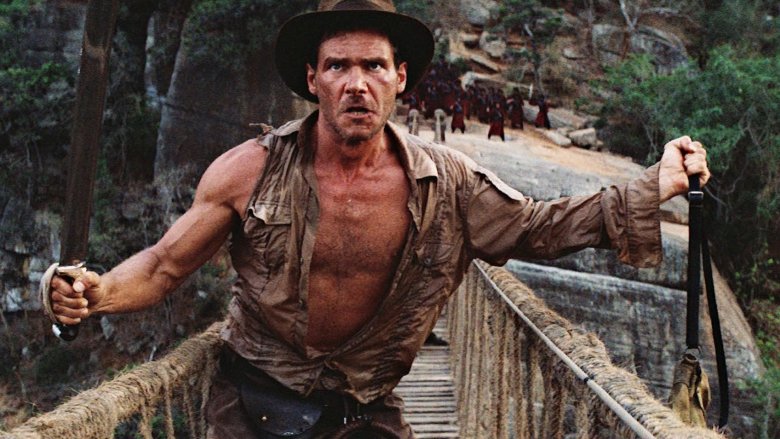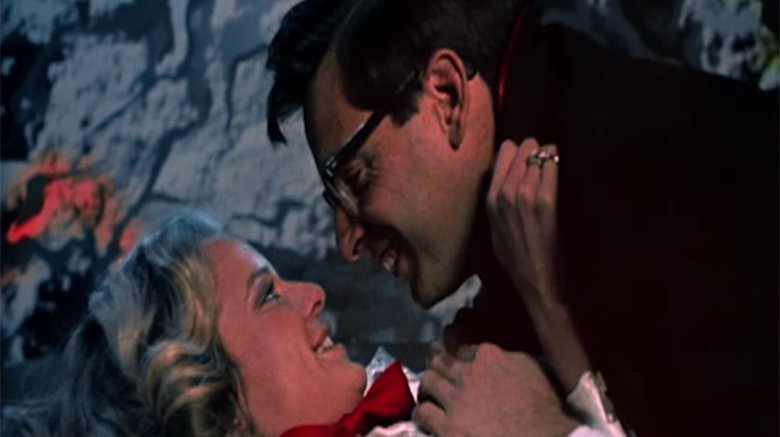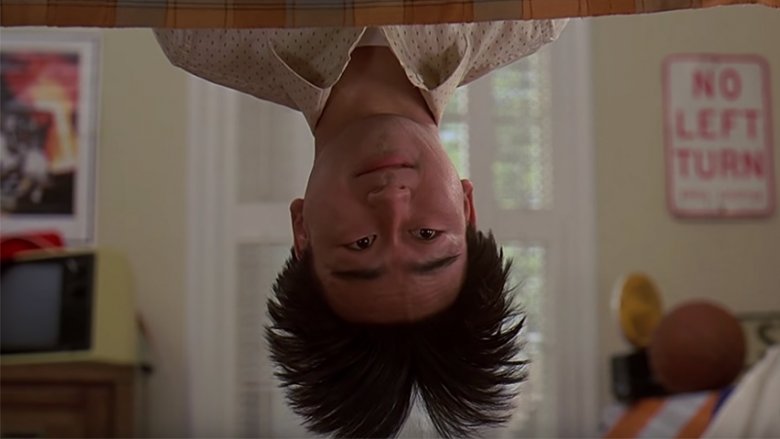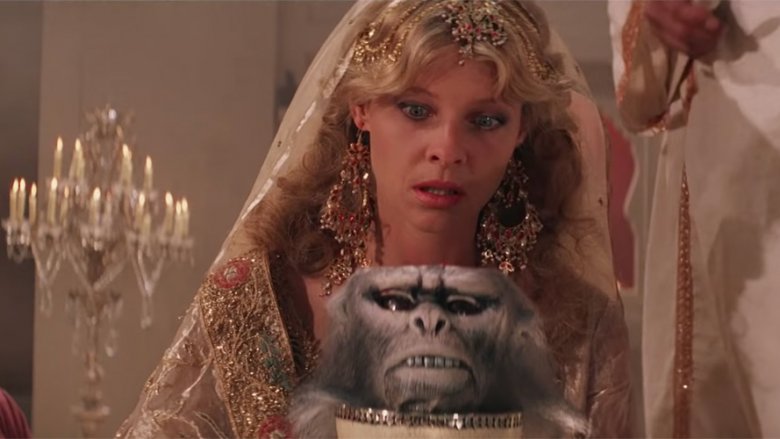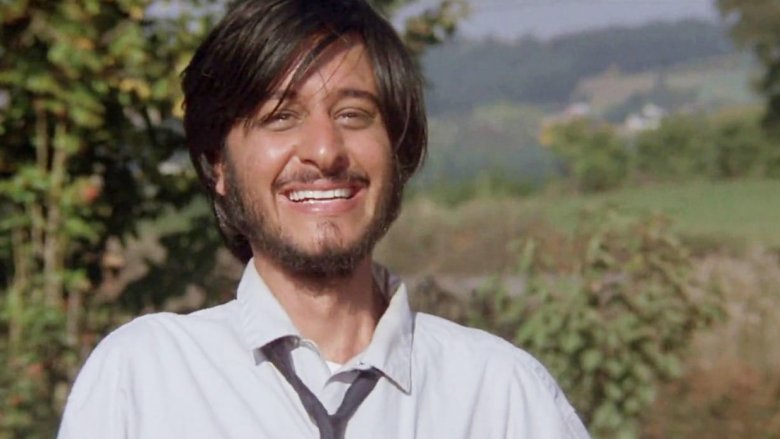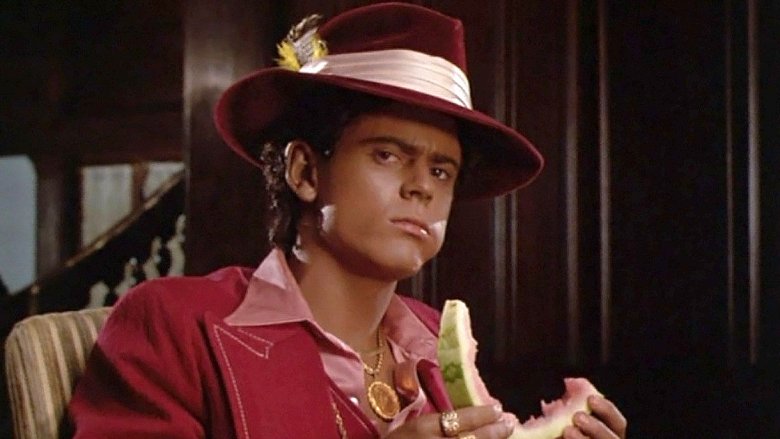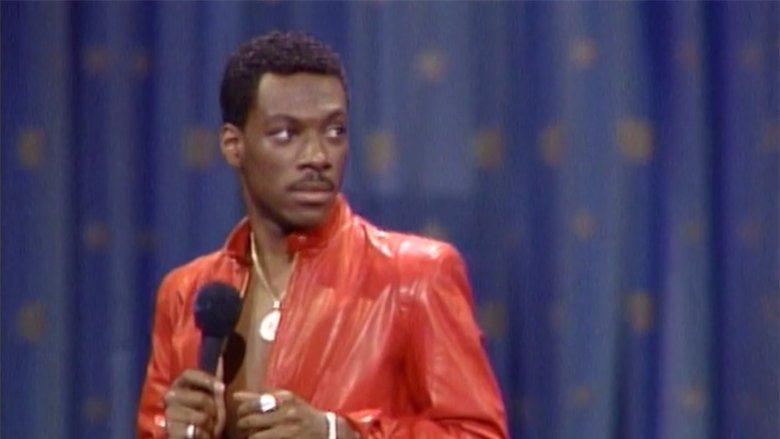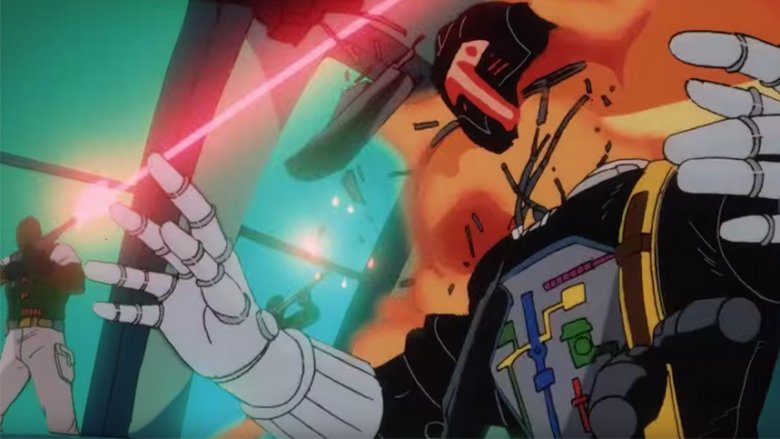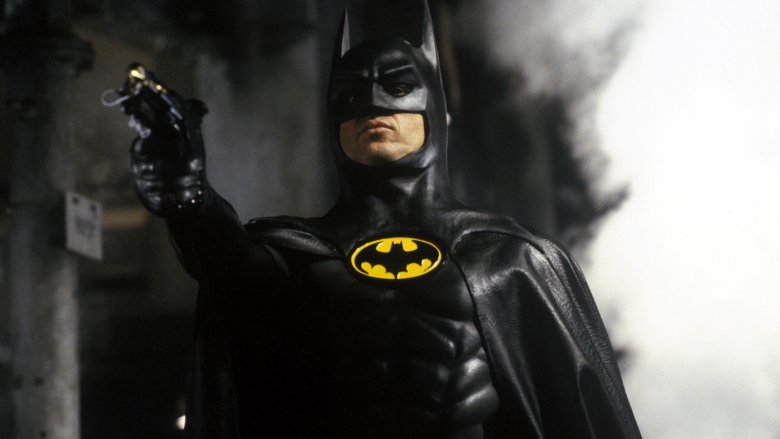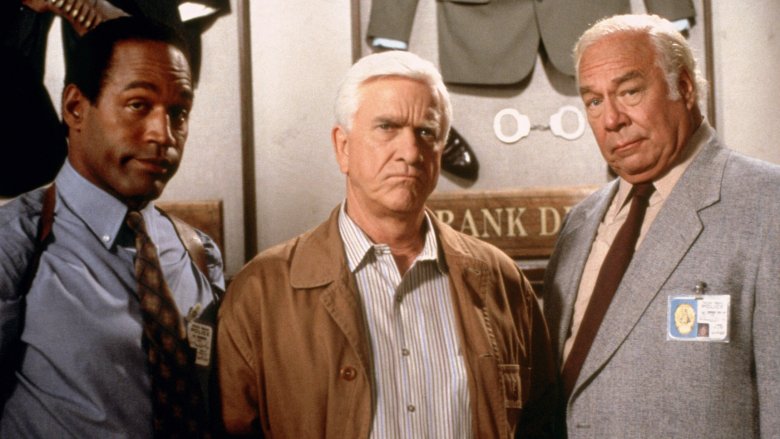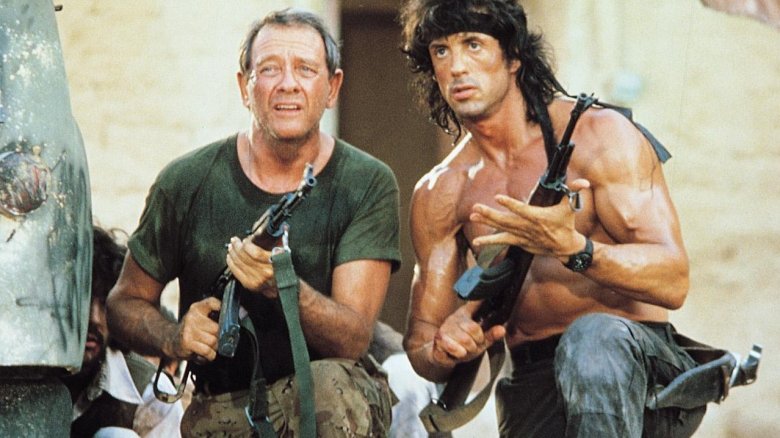'80s Movie Hits That Haven't Aged Well
Ghostbusters! Back to the Future! Raiders of the Lost Ark! The '70s might've been a high point for the art of film, but the '80s were a golden age for the popcorn hits that shaped modern pop culture, with plenty of movies that we're still watching — and loving — today. The good news is that over the past 30 years or so, we've moved towards a more progressive and enlightened society. The bad news is that some of those '80s classics are stuck in time, with all the problematic content that goes along with it.
While it's tempting to excuse some of our favorites as the product of their time, the fact is that there are plenty of hits that just haven't aged well. From insultingly racist caricatures that it's hard to believe were still happening that recently to unfortunate casting choices that are a little uncomfortable now that we know a little more about the stars, here are a few of the '80s hits that are a little tougher than most to go back to.
Revenge of the Nerds (1984)
After National Lampoon's Animal House hit theaters in 1978 to jumpstart a new wave of them, the '80s pretty much defined the idea of the "slobs vs. snobs" comedy. Caddyshack, Stripes, Police Academy, Back to School — the list goes on and on, and you can find elements of plucky misfits taking on snooty rich kids even in movies where it's not quite the focus, like the parts of The Goonies that aren't about death traps and pirate treasure. Even in that lineup, though, Revenge of the Nerds stands out as the movie that embodies the genre in every way, right down to the title.
Unfortunately, in an attempt to recreate the dynamic of Animal House's story of a delinquent fraternity sticking it to the snobs, Revenge of the Nerds amped up every aspect of that film, including all the weird sexual stuff. It might've been an accepted part of the comedy in 1984, but in the years since the film first hit theaters, a critical re-examination of its place in pop culture has correctly identified the scene of Lewis pretending to be Stan in order to have sex with Betty as a rape by deception, and the fact that this causes her to fall in love with him is just plain gross.
As fun as it might be to see the goofy Lambda Lambda Lambdas get up to hijinx, the fact that the movie plays sexual assault and distributing nude photos without the consent of their subjects for laughs makes it pretty uncomfortable to go back to this one.
Sixteen Candles (1984)
Along with The Breakfast Club and Pretty In Pink, Sixteen Candles is one of the definitive teen movies of the '80s. It's the archetypical John Hughes film to the point of being cliché, with Molly Ringwald starring as a put-upon teenager with a family that forgets her birthday and winds up as the victim of a bet made by the popular boys to see who can seduce her. It's also a movie that has bigger problems than a large-print Algebra textbook.
The most infamous, of course, is the character of Long Duk Dong, who sparked protests from Asian-American moviegoers and was described by NPR as "stereotypical, racist and part of a long history of Hollywood's offensive depictions of Asian men." On the flip side, Roger Ebert wrote that actor Gedde Watanabe "elevates his role from a potentially offensive stereotype to high comedy," but an elevated stereotype is still a stereotype, and it makes the movie a rough one to revisit, especially when there's a gong added to the soundtrack any time he says his name.
If that wasn't bad enough, though, the film's portrayal of sex was hardly progressive. That's something that it shares with a lot of its contemporaries, but Sixteen Candles is especially egregious for a scene when Jake remarks that mean-girl Prom Queen Caroline is so drunk that he "could violate her 10 different ways if I wanted to," and then decides to use her as a bargaining chip instead, handing her off to another character to do with what he will as a payoff. It's a cringe-inducing artifact that, as writer Amy Benfer put it, "only works because people were stupid about date rape at the time."
Indiana Jones and the Temple of Doom (1984)
Raiders of the Lost Ark is about as close as you can get to a perfect adventure movie. It's got a memorable lead character, thrilling set pieces, Nazis who get their faces melted off, and it does an amazing job of reviving the best parts of the serials from the '40s that inspired it. The sequel, on the other hand, manages to keep that great main character and those memorable set pieces, but combines them with the worst part of those serials: racist portrayals of "exotic" cultures and the White Savior narrative.
From the moment that the ridiculously elaborate opening musical number gives way to Indy, Willie, and Short Round being dropped into India, moviegoers relived exactly the kinds of cultural stereotypes that were around in "Jungle Adventure" stories from four decades earlier, including iompoverished villagers who need a strapping American explorer to save them, accompanied by a one-dimensional shrieking damsel who exists only to be grossed out by everything around her.
At heart, this is a movie that tries to have it both ways with its attitude towards those old-fashioned tropes. Indy himself, the guy that we're supposed to like and admire as the hero, is pretty chill about the culture clash that makes up the first half of the movie, and even admonishes Willie for her insulting behavior. At the same time, it's a movie that goes out of its way to gross out the audience with its portrayal of India as a land where evil mystics use mind control voodoo dolls to worship strange, foreign gods between meals of eyeballs and brains.
Short Circuit (1986)
Hollywood has a long and shameful history of white actors playing characters of color. By the '80s, however, the film industry had moved past relics like Mickey Rooney's infamous portrayal of Mr. Yunioshi in Breakfast at Tiffany's or Peter Sellers in The Party, right? Wrong.
Short Circuit, the story of a wacky sentient robot named Johnny Five trying to escape his creators, debuted at #1 at the box office, and earned enough money to warrant a sequel where Johnny was beaten to death with a sledgehammer and then given American citizenship, in that order. Both films also featured Fisher Stevens as a scientist named Ben Jabituya (or Jahveri in the sequel). Ben is Indian. Fisher Stevens is not.
To prepare for his role, Stevens visited India and stayed with families there in order to give Ben an emotional core that he could draw on while acting, and asked the studio to hire an Indian-Canadian accountant to act as a consultant during the filming of Short Circuit 2. That's an admirable commitment to the part — especially for a movie like Short Circuit 2, in which there is very little to admire — but it seems like a lot of trouble to go through when you could just, you know, hire an Indian actor to play Ben instead.
Soul Man (1986)
When he was discussing Soul Man in 2013, actor C. Thomas Howell said "this isn't a movie about blackface," which is a pretty weird thing to say about a movie that is literally about blackface.
Like, it's not incidental, or part of a side plot, or something that happens in an isolated section like the infamously racist minstrel show segment of Holiday Inn. That's something that can, and often is, cut out without impacting the plot. Soul Man, on the other hand, is a movie whose entire plot is built around a rich white college student named Mark (Howell) who darkens his skin in order to get a scholarship meant for black students. There's no getting around it — without the blackface aspects that drive the entire film, there is no film, so whether or not that's what the movie is about isn't really up for debate.
What is up for debate is whether the movie did more harm than good. The stance of the filmmakers, including Howell and co-star Rae Dawn Chong, was that Mark was always meant to be in the wrong for what he was doing, and that the film was meant to explore the absurdity of racism through comedy. Critics, however — including filmmaker Spike Lee and Willis Edwards, Los Angeles chapter president of the NAACP — saw the film as using blackface for a cheap gag, and also noted that Mark effortlessly gets a scholarship meant for black students because "no black student could be found in all of Los Angeles who was academically qualified." Regardless of whether you think the movie's intentions outweigh its harm, a premise that was probably a bad idea in 1986 is definitely a bad one to revisit today.
Eddie Murphy: Delirious (1983)
In the 1980s, there was a huge boom in stand-up comedy, sparked by the massive success of stars like Eddie Murphy. Over the course of the decade, Murphy would star in two feature-length concert films — Delirious, released on HBO in 1983, and Raw, released theatrically in 1987, and to say they were massively successful is putting it lightly. At the box office, Raw racked up over $50,000,000, becoming the highest-grossing stand-up comedy film of all time.
And as you might expect if you've ever seen any popular stand-up from the '80s, they've got a lot of content that'll make you cringe when you go back to them. Delirious in particular is marked by monumentally homophobic jokes that include a bit about women giving their husbands AIDS after hanging out with gay men that is, to say the least, wildly inaccurate. Under the best circumstances, the homophobia and misinformation surrounding the '80s AIDS epidemic is hard to get through, and it's especially difficult when it's played for laughs.
Murphy was only 22 when Delirious was recorded, and while that doesn't excuse the content here, it's worth noting that Murphy apologized for those bits in the '90s, saying "like the rest of the world, I am more educated about AIDS in 1996 than I was in 1981," and that he "deeply regrets any pain that I caused" with his use of slurs.
G.I. Joe: The Movie (1987)
Most of the films on this list haven't aged well because we, as a culture, have moved past the more offensive parts of their content. With G.I. Joe: The Movie, however — originally intended for theaters but released direct-to-video after the Transformers movie underperformed — it's less about stereotypes and slurs, and more about figuring out just what the hell is happening.
In an effort to give their military fantasy toy line an adventure worthy of the big screen, or at least the VHS tapes that it ended up on, the Joe movie decided to expand its focus into some full-on Dungeons & Dragons nonsense. Rather than expanding on what kids had always known as "a ruthless terrorist organization determined to rule the world," the people who were trying to blow up the Statue of Liberty in the admittedly awesome opening sequence were revealed to be the last descendants of an ancient magical snake culture.
The motivation here is pretty easy to suss out, in that kids like monsters, so adding some monsters to the toy line probably seemed like a surefire formula for success. If you're old enough to look past the inherent radness of a Nemesis Enforcer figure, though, you might appreciate having something like a plot, or an explanation of whether Sgt. Slaughter is supposed to be an actual pro wrestler, or how they expected to fight an army of snake men with a dude who's just really good at basketball. Any movie that asks all these questions should maybe try to answer at least one of them.
Batman (1989)
Superhero movies are the biggest thing in the world today, with massive, sprawling franchises that have brought plenty of four-color action to the big screen. The Marvel Cinematic Universe, for example, is made up of a slew of interlinked films, and has brought concepts like Ant-Man, Thanos, and the Infinity Gauntlet to the screen in a way that's still true to their comic book roots. That wasn't always the case, though.
In 1989, Tim Burton's Batman was a massive hit with a huge pop cultural impact that reintroduced the Dark Knight to an entire generation that, outside of comics, only knew him from Super Friends and the 1960s Adam West show. Unfortunately, while Batman '89 has an incredible visual style, it doesn't quite have the substance to back it up.
In the years since, we've had multiple film versions of Batman that range from the hilariously goofy (Batman & Robin) to the serious and psychologically driven (The Dark Knight) to a grumpy killer in a suit of power armor (Batman v Superman), and that's just in live-action film. Compared to them, Burton's vision of a wealthy weirdo who sleeps upside down and is driven by vengeance against one specific villain feels like it's just another Batman rather than a definitive take, and even Jack Nicholson's Joker has been overshadowed by Heath Ledger's version. It's still considered a favorite by many fans, but it certainly doesn't seem like the revolutionary take on the character that it once was when you're looking back at it now.
The Naked Gun (1988)
Comedy as a genre has what is arguably the greatest difficulty when it comes to withstanding the test of time. So much of what we find funny is rooted in a shared experience in the wider culture, especially when the humor relies so much on references. The further we get from those common touchstones, the less relevant — and therefore less funny — those jokes become.
That's not really the problem with The Naked Gun, though. This one didn't age well mostly because the guy playing the main character's sidekick is most famous today from being the subject of the most prominent murder trial of the past 50 years.
That guy, of course, is O.J. Simpson, whose wacky antics as Nordberg were probably a lot more funny before "Heisman-winning former football player" was replaced by "chief suspect in a double homicide" as the thing most people think of first when he comes to mind. Even though Simpson was acquitted of the murders (and then found "liable" in a civil trial, and then maybe wrote a book about how he would've done it if he had, and then was convicted on unrelated charges), that's a lot to keep in your mind when you're supposed to be laughing at someone stumbling face-first into a wedding cake.
Rambo III (1988)
No franchise has ever gone through as bizarre a transformation as the Rambo series. What started in First Blood, the dramatic thriller about a traumatized veteran being harassed by crooked cops after returning home to a country that didn't appreciate what he'd gone through, wound up turning into a cartoonish blood-'n'-guts popcorn action franchise that even spawned a literal cartoon in the form of a bizarre and short-lived G.I. Joe knockoff. The franchise hit the peak of its excesses in 1988 with Rambo III, which was entered into the Guinness Book of World Records in 1990 as the most violent film of all time.
The excessive violence is pretty typical of the heyday of over-the-top action movies, though, and so is the full-on propaganda of an American hero fighting against the Soviet military. That's where the big problems come in, specifically in that in an effort to fight off the ruthless, evil Russian general, Rambo teams up with the guerrilla Mujahideen forces in Afghanistan, to whom the movie is dedicated.
As for why that's a problem, well, here's the short version. Rambo's pals in the Afghan Mujahideen would later evolve into the fundamentalist movement called the Taliban, which would then ally itself with Al-Qaeda, the terrorist organization led by Osama bin Laden that, among other atrocities, would be responsible for the attacks on the World Trade Center and the Pentagon on September 11, 2001, which you may have heard of. Even going into Rambo III knowing that it was anti-Soviet propaganda dressed up in a massive number of mindless cinematic explosions, having the hindsight of the past 20 years since 9/11 makes it tough to think about anything else while you're watching.
